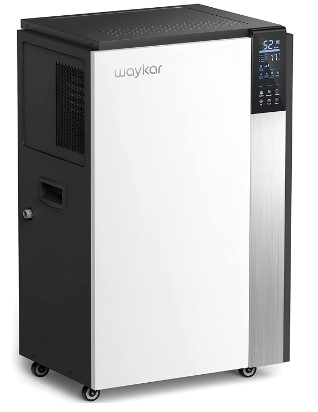Attaining the right humidity level for your home can be challenging because of the different factors that influence indoor air quality.
Learning about the correlation between factors like temperature, wind speed and direction, rainfall, ventilation, and indoor air conditioning, can help you attain the right indoor humidity.
Dehumidifier settings for winter can differ from the setting you normally use during other seasons depending on factors like outdoor and indoor humidity, indoor activities, and the air condition in your local or geographical area.
If you are unsure about the right dehumidifier settings for your device, especially during winter when the humidity levels might be slightly lower than in other seasons, you can tweak your dehumidifier settings a little to reduce the level of humidity removed from your indoor air.
We understand that determining the right setting for your dehumidifier can be challenging especially if you are using a whole-house dehumidifier and do not want to mess with the quality of your indoor air. This article will help you determine the best settings for your dehumidifier during the winter season.
In this post, we will cover the following:
- Should I run my dehumidifier in winter?
- Dehumidifier settings for winter
- What level should a dehumidifier be set at?
- How do you dehumidify in winter?
- Does a dehumidifier make a room warmer in winter?
Should I Run My Dehumidifier in Winter?
You should run your dehumidifier in winter if your indoor air has excess humidity levels. Generally, the relative humidity is usually low during winter. People are also likely to notice low humidity levels or dry air during the winter when compared to other seasons.
Some of the factors that can contribute to excess indoor humidity during winter include:
Cracks and Spaces
If there are any cracks in your walls, spaces near your windows or doors, or any other openings that have not been sealed well, snow can easily make its way inside your home, especially if it is extremely windy.
Since the air inside your home is likely to be warmer than the air outside your home during winter, the snow will melt, leaving behind a puddle of water or droplets of moisture on the surfaces where the snow had accumulated.
These water droplets will be the source of excess humidity in your home and can also damage the surfaces where they accumulate by causing the growth of mold or wood rot.
Laundry
Doing your laundry indoors and handing your clothes indoors to dry during winter can contribute to excess indoor humidity that might make your indoor space musty and uncomfortable.
If you hand your clothes indoors to dry during winter, you should consider using a dehumidifier during the winter season to absorb the excess moisture in the air.
On the other hand, if the air in your home is not excessively dry, you might not need to use the dehumidifier after drying your laundry.
Note: Using a dehumidifier while drying your laundry indoors during winter can also speed up the rate at which your clothes dry.
Some dehumidifiers have been designed with a laundry mode, which allows them to remove humidity from your indoor air at a faster rate when you want to dry your clothes.
An example of a great all-weather dehumidifier is the Waykar 296 pint dehumidifier which can be used in both industrial spaces and in large homes to remove excess humidity, especially in areas such as the basement or attic that might harbor excess humidity.
Waykar 296 Pint Dehumidifier

Features
- Area coverage: Approximately 8000 sq. ft.
- Auto defrost
- Drain hose included
- Power outage restart
- Auto shut-off
- Maximum moisture removal per day 296 pints
- Quiet operation
- Intelligent touch control
- Senses room humidity levels and adjust dehumidification function
- A great option for basements or rooms with high humidity levels
Pros
- Great value for money
- Energy efficient
- Easy to use
- Detects indoor humidity changes and adjusts moisture removal rate
Con
- Quite pricey compared to smaller dehumidifiers
Cooking
When you are cooking, some of the steam from the food can accumulate in your kitchen making the air excessively humid.
While the additional humidity and warm air in the kitchen might be a great method for getting rid of cold air and dry air during winter, excessive accumulation of steam in your kitchen can affect the quality of air in that room.
If you notice mold growth on your walls or under your kitchen sink while cooking or you notice feel like you are struggling to breathe properly because of the excess humidity in the room, you can use your dehumidifier to get rid of the excess humidity.
Shower
Your shower can also be a source of excess humidity in your home, especially if you shower several times a day or if there are many occupants in your home.
To avoid dealing with mold growth on your walls or floors, you can use a dehumidifier after you have showered to eliminate the excess humidity in the air. This will also ensure that your bathroom remains clean and dry throughout the day.
Dehumidifier Settings for Winter
The correct dehumidifier setting for winter for your home will depend on your indoor humidity levels. Your indoor humidity levels might not necessarily match the level of humidity in your outdoor space.
Relative humidity of 60% and above:
If the relative humidity in your home is over 60%, you should consider using a dehumidifier to lower the humidity level in your home as the high humidity can promote mold growth and make the air in your home musty.
If the humidity level in your home is over 60% RH, mainly because of an activity like cooking or showering, you might only need to use the dehumidifier for a short time to lower the humidity level and then switch off the dehumidifier.
Monitoring your indoor humidity level will help you determine when you need to use your dehumidifier for a few hours, the whole day, or several days depending on the factors influencing the humidity levels.
It is also important to note that running your dehumidifier for excessively long periods could significantly lower your indoor humidity levels and contribute to air dryness, which is a common problem during the winter season (as the outdoor air already contains a relatively low level of humidity).
Relative humidity of 55% to 60%:
When the humidity level in your home is in the range of 55 to 60% RH, you will need to use your dehumidifier for a few hours to lower the humidity levels to around 50% RH or ensure that the humidity level is maintained at around 55% RH.
Relative humidity of 45 to 50%:
Relative humidity of between 40 to 50% is fairly okay, especially during the winter season when the humidity levels tend to be quite low. You will not need to run your dehumidifier when the humidity level is within this range.
Relative humidity of less than 45%:
If your indoor humidity level is less than 45%, you should not run your dehumidifier because it will lower the humidity level further and make the air in your room or home dry.
Instead of using a dehumidifier, you are more likely to benefit from using a humidifier when the indoor humidity in your home is very low.
What Level Should a Dehumidifier Be Set At?
Ideally, a dehumidifier should be set anywhere between 50 to 55% RH. This will ensure that the dehumidifier does not remove excess humidity from your indoor air or stop working while there are still high levels of humidity in your home.
An indoor RH of 50 to 55% is perfect for all seasons including winter where the humidity levels in your home are likely to be fairly low.
Some dehumidifiers have automatic features that enable them to detect changes in your indoor humidity levels and adjust their dehumidification roles accordingly while others need to be adjusted manually based on the humidistat reading.
Regardless of the type of dehumidifier that you are using, it is important to check your humidistat or hygrometer regularly to determine your indoor humidity level.
How do you Dehumidify in Winter?
If you do not have a dehumidifier and you are not keen on buying one, but still want to get rid of excess indoor humidity during winter, you could opt for alternative dehumidifying options.
Air conditioner settings
Check your air conditioning settings to ensure that they are correct. Air conditioners cool your indoor air and also remove excess heat and humidity from the indoor space. If the air conditioner is not working properly your indoor air might be more humid than what you would consider comfortable.
Use humidity-lowering plants
Some plants are effective in absorbing excess humidity from their surroundings. Examples like euphorbias and aloe plants are great for trapping moisture from the air and reducing humidity in indoor spaces.
Ceiling Fans and Windows
Using a ceiling fan can also reduce the humidity level in your home. If you are cooking and notice that the humidity in your home is quite high, you could opt to use your ceiling fan to regulate the humidity level.
Naturally, hot air rises while cool air settles at the bottom. Running the ceiling fan will help dry the humid air, especially if a window is open to promote the movement of cold air indoors.
Note that, you should not keep the window open for a long time because it will promote the accumulation of snow and water puddles from the snow inside your home.
Fix Wall Cracks and Air Leaks

Ensure that you fix any air leaks and cracks in your home as they might be a source of moisture, especially if snow manages to pass through the cracks or air leaks.
During winter the air in your home is likely to be warmer when compared to the outdoor air. Fixing any cracks in your walls will also preserve the warmth in your home and prevent insects like spiders, which might also be trying to get away from the cold, from getting in your home.
Check out the article below to learn more about the role of dehumidifiers in keeping spiders and other small insects out of your home.
Recommended Read: How dehumidifiers can help keep spiders out of your home
Does a Dehumidifier Make a Room Warmer in Winter?
A dehumidifier can increase the room temperature in your home slightly, which might make the room warmer, especially during the winter season, which is characterized by extreme cold.
You might not necessarily notice the change in the temperature of your indoor air, especially if you are using a small portable dehumidifier.
When you run your dehumidifier, it draws in room-temperature air filled with humidity in the dehumidifier. The processes that the humid air undergoes to remove the water molecules from the air and condense the water molecules generate heat, making the air released slightly warmer.